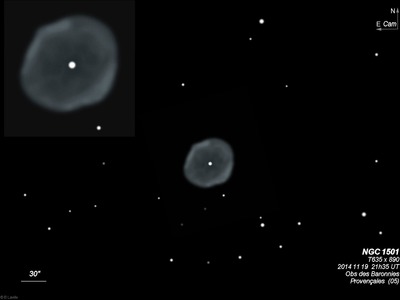
William Herschel discovered NGC 1501 = H IV-53 on 3 Nov 1787 (sweep 774) using the front-view (no secondary) design with a power of 157. He described "a very curious planetary nebula of nearly 1' in diameter; it is round, pretty well defined of a uniform light and pretty bright." Just 6 nights later, he reported "with 360 much magnitified, but still the borders pretty abruptly defined, irregularly elliptical." John Herschel didn't report an observation.
On 15 Jan 1868 Lawrence Parsons, the son of Lord Rosse, reported "a bright ring and inside it a dark annulus, very decided. A star in the centre seen very clearly and continuously with various powers; suspect variable [unequal?] brightness in the ring, perhaps a dark spot in it nearly on the p side. The f side of the ring appears broadest and to approach the central star nearer than the preceding side does. The n and s sides of the ring seem rather brighter than the p and f sides. Suspect other bright points in it, but am not at all certain. It is slightly elliptical, its major axis being nearly p and f."
Based on a Crossley photograph, Curtis (1918) described, "central star nearly mag 12, surrounded by a very irregular and patchy elliptical disk, about 56"x48" in pa 98?. The periphery shows traces of a broken ring formation the brightest portions are the edges at the ends of the minor axis."
On a 60-inch Mt Wilson photograph, Pease (1917) reported "this is a fine planetary of regular elliptical shape, 60"x45", p.a. 120?, with protuberances at each end of the minor axis making a total breadth 53". The nebula is irregularly mottled, bearing a resemblance to the convolutions of the brain."
200/250mm - 8" fairly faint, moderately large, bluish, slightly elongated, sharp-edged.
300/350mm - 13.1" (1/28/84): slightly annular, very faint mag 14 central star visible.
400/500mm - 17.5" (1/8/00): at 100x, this moderately bright PN was irregularly round, 1' diameter, weakly annular with a faint glimpse of the central star. There was a good contrast gain with the OIII filter and the image was crisp-edged, slightly elongated SW-NE and the small, darker center was more evident. Excellent view at 220x with the faint central star (mag 14.4) clearly visible. The surface brightness was irregular with an unevenly brighter outer rim. The central star was visible steadily at 280x and the overall surface brightness was mottled or "clumpy" (brighter on west and NE rim), darkening in the center.
17.5" (9/14/85): bright, moderately large, almost round, 1' diameter, high surface brightness. An easy mag 14.2 central star is visible. Appears darker near the central star with a brighter rim.
Notes by Steve Gottlieb